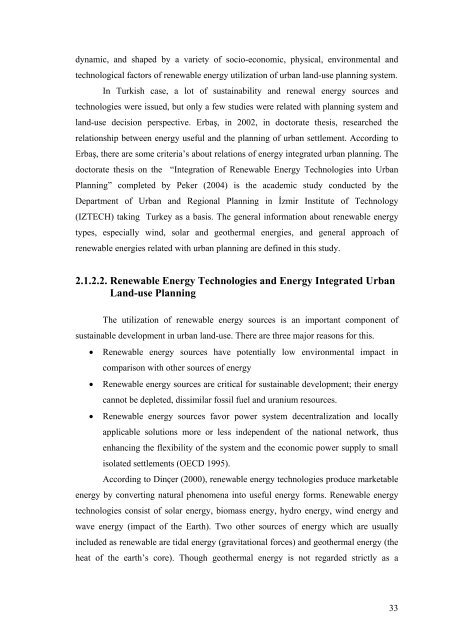developing a strategic decision-making process for local energy ...
developing a strategic decision-making process for local energy ...
developing a strategic decision-making process for local energy ...
Create successful ePaper yourself
Turn your PDF publications into a flip-book with our unique Google optimized e-Paper software.
dynamic, and shaped by a variety of socio-economic, physical, environmental and<br />
technological factors of renewable <strong>energy</strong> utilization of urban land-use planning system.<br />
In Turkish case, a lot of sustainability and renewal <strong>energy</strong> sources and<br />
technologies were issued, but only a few studies were related with planning system and<br />
land-use <strong>decision</strong> perspective. Erbaş, in 2002, in doctorate thesis, researched the<br />
relationship between <strong>energy</strong> useful and the planning of urban settlement. According to<br />
Erbaş, there are some criteria’s about relations of <strong>energy</strong> integrated urban planning. The<br />
doctorate thesis on the “Integration of Renewable Energy Technologies into Urban<br />
Planning” completed by Peker (2004) is the academic study conducted by the<br />
Department of Urban and Regional Planning in İzmir Institute of Technology<br />
(IZTECH) taking Turkey as a basis. The general in<strong>for</strong>mation about renewable <strong>energy</strong><br />
types, especially wind, solar and geothermal energies, and general approach of<br />
renewable energies related with urban planning are defined in this study.<br />
2.1.2.2. Renewable Energy Technologies and Energy Integrated Urban<br />
Land-use Planning<br />
The utilization of renewable <strong>energy</strong> sources is an important component of<br />
sustainable development in urban land-use. There are three major reasons <strong>for</strong> this.<br />
• Renewable <strong>energy</strong> sources have potentially low environmental impact in<br />
comparison with other sources of <strong>energy</strong><br />
• Renewable <strong>energy</strong> sources are critical <strong>for</strong> sustainable development; their <strong>energy</strong><br />
cannot be depleted, dissimilar fossil fuel and uranium resources.<br />
• Renewable <strong>energy</strong> sources favor power system decentralization and <strong>local</strong>ly<br />
applicable solutions more or less independent of the national network, thus<br />
enhancing the flexibility of the system and the economic power supply to small<br />
isolated settlements (OECD 1995).<br />
According to Dinçer (2000), renewable <strong>energy</strong> technologies produce marketable<br />
<strong>energy</strong> by converting natural phenomena into useful <strong>energy</strong> <strong>for</strong>ms. Renewable <strong>energy</strong><br />
technologies consist of solar <strong>energy</strong>, biomass <strong>energy</strong>, hydro <strong>energy</strong>, wind <strong>energy</strong> and<br />
wave <strong>energy</strong> (impact of the Earth). Two other sources of <strong>energy</strong> which are usually<br />
included as renewable are tidal <strong>energy</strong> (gravitational <strong>for</strong>ces) and geothermal <strong>energy</strong> (the<br />
heat of the earth’s core). Though geothermal <strong>energy</strong> is not regarded strictly as a<br />
33
















